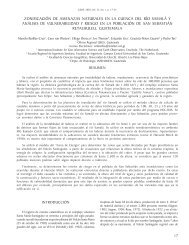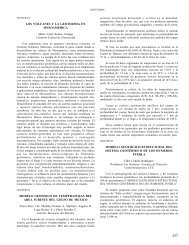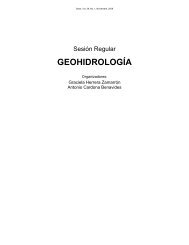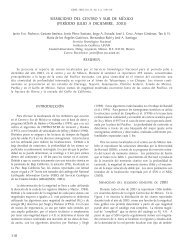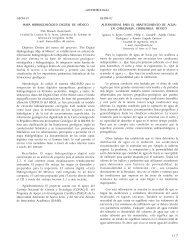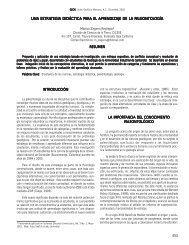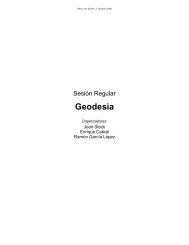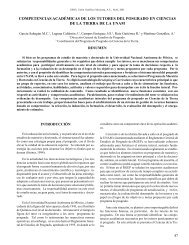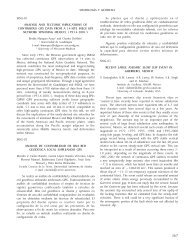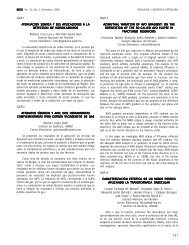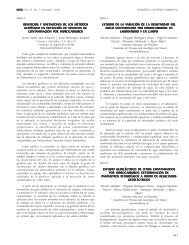Libro de Resúmenes - Unión Geofisica Mexicana AC
Libro de Resúmenes - Unión Geofisica Mexicana AC
Libro de Resúmenes - Unión Geofisica Mexicana AC
Create successful ePaper yourself
Turn your PDF publications into a flip-book with our unique Google optimized e-Paper software.
MODEL<strong>AC</strong>IÓN MATEMÁTICA COMPUT<strong>AC</strong>IONAL DE SISTEMAS TERRESTRES Geos, Vol. 30, No. 1, Noviembre, 2010<br />
SE11-1<br />
EFFICIENT SPLITTING METHOD FOR SOLVING<br />
THE DIFFUSION EQUATION ON A SPHERE<br />
Skiba Yuri 1 y Filatov Denis 2<br />
1 Centro <strong>de</strong> Ciencias <strong>de</strong> la Atmósfera, UNAM<br />
2 Centro <strong>de</strong> Investigaciones Computacionales, IPN<br />
skiba@servidor.unam.mx<br />
A new method of constructing balanced finite-difference schemes for <strong>de</strong>scribing<br />
the diffusion dynamics on a sphere has been <strong>de</strong>veloped [1]. The main i<strong>de</strong>a<br />
is the use of coordinate splitting of the original diffusion equation and the<br />
subsequent construction of one-dimensional balanced schemes [2]. The splitting<br />
is accompanied with the Crank-Nicolson or/and purely implicit approximation<br />
in time. Although the sphere is not a doubly periodic manifold, the approach<br />
allows to employ two coordinate maps for covering the sphere and thus to use<br />
periodic boundary conditions for solving the split one-dimensional problems in<br />
both directions [3-4]. This approach does not require imposing artificial boundary<br />
conditions at the poles, and allows increasing the spatial accuracy [3-6]. As an<br />
example, a fourth-or<strong>de</strong>r finite difference scheme for the linear diffusion equation<br />
is given. The schemes are computationally inexpensive and can be solved by<br />
direct band linear solvers. Numerical experiments have <strong>de</strong>monstrated that the<br />
approach allows a<strong>de</strong>quate simulating both homogeneous and heterogeneous<br />
diffusion processes (that is, both with constant and variable diffusion coefficient)<br />
all over the sphere. Upon this, the properties of balance of the total amount of the<br />
substance and the substance dissipation in the L2-norm are properly satisfied.<br />
In spite of the fact that the method is <strong>de</strong>scribed for the linear diffusion equation,<br />
it can directly be applied to a nonlinear diffusion problem if one linearizes the<br />
original equation in each small time interval and uses the coordinate splitting.<br />
In<strong>de</strong>ed, then each split one-dimensional linearized problem will have the same<br />
form as in the case of linear diffusion provi<strong>de</strong>d that the diffusion coefficient<br />
<strong>de</strong>pends now on the solution value taken from the previous time step.<br />
The numerical experiments <strong>de</strong>monstrate a small gain of the Crank-Nicolson<br />
approximation over the purely implicit scheme for the linear mo<strong>de</strong>l. However, for<br />
the nonlinear mo<strong>de</strong>l both schemes provi<strong>de</strong> almost indistinguishable results.<br />
References:<br />
1. Yu.N. Skiba and D.M. Filatov (2010), On an Efficient Splitting-Based Method<br />
for Solving the Diffusion Equation on a Sphere. Numer. Meth. PDE (in press).<br />
2. Yu.N. Skiba (1995), Finite-Difference Mass and Total Energy Conserving<br />
Schemes for Shallow-Water Equations, Russian Meteor. & Hydrol., 2, 35-43.<br />
3. Yu.N. Skiba and D.M. Filatov (2007), On Splitting-based Mass and Total<br />
Energy Conserving Arbitrary Or<strong>de</strong>r Shallow-Water Schemes, Numer. Meth.<br />
PDE, 23 (3), 534-552.<br />
4. Yu.N. Skiba and D.M. Filatov (2008), Conservative Arbitrary Or<strong>de</strong>r Finite<br />
Difference Schemes for Shallow-Water Flows, J. Comp. Appl. Math., 218 (2),<br />
579-591.<br />
5. Yu.N. Skiba and D.M. Filatov (2009), Mass and Energy Conserving Fully<br />
Discrete Schemes for the Shallow-Water Equations, in: G. Spadoni (ed.), Energy<br />
Conservation: New Research, Nova Science Publishers, USA, 155-197.<br />
6. Skiba Yu.N. and D.M. Filatov (2009), Simulation of Soliton-like Waves<br />
Generated by Topography with Conservative Fully Discrete Shallow-Water<br />
Arbitrary-Or<strong>de</strong>r Schemes. Intern. J. Numer. Meth. Heat & Fluid Flow, 19 (8),<br />
982-1007.<br />
SE11-2<br />
ALGUNOS DESARROLLOS EN EL DISEÑO<br />
ÓPTIMO DE REDES DE MONITOREO DEL AGUA<br />
SUBTERRÁNEA UTILIZANDO MODELOS ESTOCÁSTICOS<br />
Herrera Zamarrón Graciela 1 , Briseño Ruiz Jessica Vanessa 2 y Simuta Champo Roel 2<br />
1 Instituto <strong>de</strong> Geofísica, UNAM<br />
2 Posgrado <strong>de</strong>l Instituto <strong>de</strong> Ingeniería, UNAM<br />
ghz@geofisica.unam.mx<br />
Para reducir los costos <strong>de</strong> monitoreo <strong>de</strong> aguas subterráneas a largo plazo,<br />
Herrera (1998) <strong>de</strong>sarrolló una metodología para el diseño óptimo <strong>de</strong> re<strong>de</strong>s <strong>de</strong><br />
monitoreo espacio-temporales. En ésta se seleccionan posiciones y tiempos<br />
<strong>de</strong> monitoreo <strong>de</strong> tal forma que no proporcionen información redundante<br />
en el espacio y el tiempo. La metodología utiliza un mo<strong>de</strong>lo <strong>de</strong> flujo y<br />
transporte estocástico para pre<strong>de</strong>cir la incertidumbre que tendrían las variables<br />
a monitorear y a través <strong>de</strong> un filtro <strong>de</strong> Kalman ensamblado espacio-temporal se<br />
evalúa la reducción en esta incertidumbre <strong>de</strong>bida a la incorporación <strong>de</strong> datos<br />
obtenidos por la red <strong>de</strong> monitoreo. Para elegir las posiciones y los tiempos <strong>de</strong><br />
monitoreo óptimos, se aplica un método <strong>de</strong> optimización <strong>de</strong> adiciones sucesivas.<br />
La metodología se aplicó a un problema <strong>de</strong> campo en Herrera et al. (2001) y<br />
se presentaron algunos ejemplos <strong>de</strong> sus usos en Herrera y Pin<strong>de</strong>r (2005). La<br />
aplicación <strong>de</strong>l filtro <strong>de</strong> Kalman ensamblado requiere <strong>de</strong> simulación estocástica<br />
o monte Carlo, por lo que es necesario correr repetidas veces el mo<strong>de</strong>lo <strong>de</strong> flujo<br />
y transporte. Para reducir el número <strong>de</strong> simulaciones requeridas se probó la<br />
incorporación <strong>de</strong> un método <strong>de</strong> muestreo <strong>de</strong>l tipo hipercubo latino en Zhang et al.<br />
(2005). En el mismo trabajo se probó un algoritmo genético para llevar a cabo la<br />
optimización. Algunos avances recientes en la metodología son: 1) la posibilidad<br />
<strong>de</strong> seleccionar las profundida<strong>de</strong>s <strong>de</strong> muestreo en el diseño, y 2) el uso <strong>de</strong>l<br />
filtro <strong>de</strong> Kalman espacio-tiempo para la estimación global <strong>de</strong> los parámetros<br />
<strong>de</strong>l mo<strong>de</strong>lo estocástico. Una revisión <strong>de</strong>l <strong>de</strong>sarrollo <strong>de</strong> la metodología y los<br />
resultados más recientes se presentarán en esta plática.<br />
Herrera, G. S. (1998), Cost effective groundwater quality sampling network<br />
<strong>de</strong>sign, Ph.D. thesis, Univ. of Vt., Burlington.<br />
Herrera, G. S., and G. F. Pin<strong>de</strong>r (2005), Space#time optimization of<br />
groundwater quality sampling networks, Water Resour. Res., 41, W12407,<br />
doi:10.1029/2004WR003626.<br />
Herrera, G. S., J. Guarnaccia, G. F. Pin<strong>de</strong>r, and R. Simuta-Champo (2001),<br />
Design of efficient space-time groundwater quality sampling networks, in the<br />
proceedings of the 3rd International Symposium on Environmental Hydraulics,<br />
held in Tempe, Arizona, December 5-8, 2001.<br />
Zhang, Y., G. F. Pin<strong>de</strong>r, and G. S. Herrera (2005), Least cost <strong>de</strong>sign of<br />
groundwater quality monitoring networks, Water Resour. Res., 41, W08412,<br />
doi:10.1029/2005WR003936.<br />
SE11-3<br />
NUMERICAL SIMULATION OF THE VADOSE ZONE: EFFECT ON<br />
SIMULATED FLUXES AT THE WATER TABLE DUE TO SELECTED<br />
BOUNDARY CONDITIONS AND VERTICAL DISCRETIZATION<br />
Carrera Hernán<strong>de</strong>z Jaime J. 1 , Mendoza Carl 2 , Devito Kevin 2 y Smerdon Brian 3<br />
1 Instituto Potosino <strong>de</strong> Investigación Científica y Tecnológica<br />
2 University of Alberta<br />
3 CSIRO land and water<br />
jaime.carrera@ipicyt.edu.mx<br />
The spatial and temporal variability of recharge is important in sub-humid,<br />
semi-arid and arid regions, where from a long-term analysis, evapotranspiration<br />
exceeds rainfall but where short, high intensity rainfall and snow melt events<br />
largely exceed evapotranspiration, thus enabling the recharge process to occur.<br />
Recharge can be classified as either actual recharge, which is the water that<br />
reaches the water table, or potential recharge, which is the water that might be<br />
available for recharge, but which due to specific situations (e.g., high water table)<br />
is transformed into run-off.<br />
Because the unsaturated zone is a key element in hydrology, a large number<br />
of studies have recently used numerical mo<strong>de</strong>ls to investigate the factors that<br />
control recharge, because the unsaturated zone <strong>de</strong>termines how precipitation is<br />
partitioned into runoff, infiltration, groundwater recharge and evapotranspiration.<br />
Accordingly, unsaturated flow mo<strong>de</strong>ling is increasingly being used to estimate<br />
potential aquifer recharge. A review of previous studies shows that unit-gradient<br />
and fixed water table lower boundary conditions have been applied to mo<strong>de</strong>ls of<br />
constant and variable spatial discretization.<br />
In or<strong>de</strong>r to provi<strong>de</strong> a general guidance, this work studies the effect of both<br />
discretization and boundary conditions on simulation times and estimated fluxes<br />
at the water table, using monolithic columns of different <strong>de</strong>pths and textures.<br />
According to long-term numerical simulations (1919-2007) it can be conclu<strong>de</strong>d<br />
that a vertical discretization at both the top and bottom of the columns (varying<br />
from 0.1 to 10 cm) is recommen<strong>de</strong>d in or<strong>de</strong>r to improve simulation times. As<br />
will be illustrated, whenever the unsaturated flow mo<strong>de</strong>ling approach is used<br />
to estimate potential aquifer recharge, a fixed-head lower boundary condition<br />
should be used as it also allows upflux from the water table on dry years, a<br />
situation that is more physically-based than the unit-gradient boundary condition.<br />
SE11-4<br />
FLUJO EN M<strong>AC</strong>ROFR<strong>AC</strong>TURAS UTILIZANDO<br />
DESCOMPOSICIÓN DE DOMINIO<br />
Vera Guzmán Norberto<br />
Instituto <strong>de</strong> Geofísica, UNAM<br />
nrbrt@geofisica.unam.mx<br />
En este trabajo se presenta una forma <strong>de</strong> simular el flujo <strong>de</strong> un fluido en<br />
un medio poroso fracturado, utilizando dos mo<strong>de</strong>los macrohíbridos mixtos<br />
acoplados. Se utiliza <strong>de</strong>scomposición <strong>de</strong> dominio para replantear el problema<br />
global como un conjunto <strong>de</strong> subproblemas locales, tanto para el medio<br />
poroso como para las fracturas. De acuerdo a este enfoque, se obtienen<br />
problemas locales (n)-dimensionales para el medio poroso, y problemas locales<br />
(n-1)-dimensionales para las fracturas.<br />
La metodología que se aplica es la siguiente.<br />
1. Se consi<strong>de</strong>ra el dominio <strong>de</strong> <strong>de</strong>finición <strong>de</strong>l problema (medio poroso fracturado)<br />
Omega, como una región en 2D o en 3D.<br />
178



![Libro de resúmenes [revisión final, 172 páginas] - UGM](https://img.yumpu.com/51565067/1/190x245/libro-de-resamenes-revisian-final-172-paginas-ugm.jpg?quality=85)
